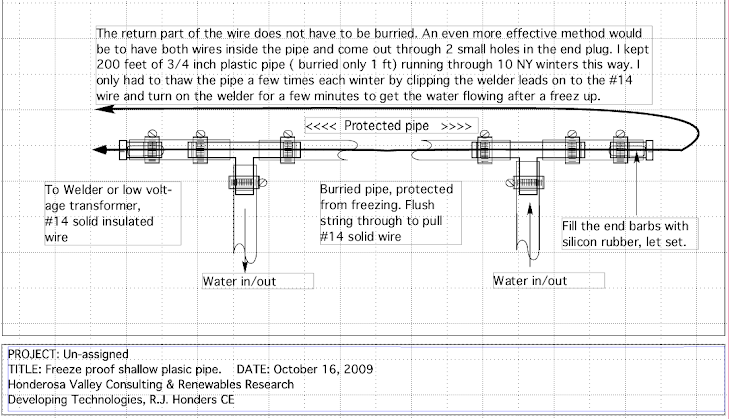Some answers, can you guess the questions?
Yep, I am asked about pumping water back up the hill about once a week. And I'm not saying 'never works' , only that you'll never get more energy out than is put in.
In some cases it pays! If electric costs at night are 1/3 of daytime charges you could make money by using twice as much electricity to pump the water up than you will get out on the trip down through the turbo generators during daytime with rates 3X higher.
A rough approximation for power (Watts) you can get from water at a height is: Gallons per minute times feet of height all divided by 14. So with the given 12 feet and 1000 gal/min you could generate about 900 watts for 15 minutes starting with the 15000 gallon tank full. To fill the tank would take a bit more than 900 Watts for a little more more than 15 minutes, and so you would end up with a net loss of energy every time around this loop. You would be better off with just a wind mill and some solar panels, and using storage batteries instead of the water tank scheme for storage.
One HP is 746 Watts, so a 100 HP motor would require 74,600 Watts for however long it runs with a load. And if you want to use the motor as generator you would have to have 74,600 Watts of water power where you only have 900 Watts for 15 minutes, or 450W for 30 minutes, or 0.225 kWatt hours from you water tank. So a half HP motor would be more appropriate as a generator.
Start with these basic numbers and estimates, then decide on the size of the equipment to handle the available energy. A 100HP motor does not make 100HP unless you put that much energy into it, either electrical or mechanical shaft rotation. It only converts mechanical to electrical and vise-versa. And if you use too big a motor (energy converter) for the energy input you will waste a lot of energy in bearing friction, windage and other losses. So it is important to match your machinery to the energy source. Don't buy machinery before you determine what the available energy sources can deliver. Measure head and flow, wind velocity over time, or sunshine over time, then calculate Watts or kiloWatts available and see if this will meet your needs at a reasonable cost. With wind and solar you can install a bigger mill or more panels to get more kWatts while the wind blows or the sun shines. With water there only flows so much for so long on average and a bigger turbo-generator may not be able to run efficiently or at all during low flow periods or dry spells.









8 comments:
Hey Rob, what if you designed a piece of property in such a way that the drainage of rainwater collected itself into a reservoir (or a system of reservoirs) that was up high enough to produce good flow? This way you wouldn't have to pump the water for storage, but you could still generate electricity from opening a valve to the rainwater storage pond/reservoirs. What are your opinions on this kind of a system? Would it be better to just direct the flow of water into the stream instead?
Thank you,
- JP
Hi Rob,
I have a technical question for you on pumps as turbines. I am planning on installing a PAT with a draft tube. My experience of draft tubes with Crossflow turbines is that the end of the draft tube needs to be submerged to stop air bubbling up and reducing the efficiency of the Crossflow, would this need for submergence be the case still with a PAT (end suction pump operating like a francis), thanks Adam
If you have any knowledge relevant to this let me know, adam@ellergreen.com thanks Adam
Yes, Adam, the end of the draft tube or discharge
pipe should be submerged by around a third of a
diameter of the end of the tube.
Suction head should be less than 20 feet as you will get
cavitation and draw a vacuum with much more than
that. If you use a discharge pit and go straight down
you will need to flare out the pipe or construct a
diffuser in the bottom to keep from eroding a hole
down through the bottom of the pit.
Very nice blog to share info about Renewable Energy Stocks- Insight Into Global Green Investing
Good piece of information on energy.
Hi Rob,
Firs of all, thank you for sharing your knowledge on PAT.I wanted to built on of this too and i am wondering if 4inc pvc penstock can handle it. My place is 1300 feet long penstock with overhead of 150 feet. tahnks again.
Hi Daniel,
You did not mention your flow or the water source volume so I can not really say if a 4 inch pipe is sufficient.
Your basic questions are best answered by keeping in mind that the power out of any hydro setup is primarily dependent on head and flow. So these two need to maximized to get the power you want. So anything that reduces pressure (head) is to be avoided. Anything that reduces flow (small pipes) should be avoided or you'll get less power output, maybe so little it won't be worth the bother, expense, and continuing maintenance, like keeping trash racks and filters cleared.
Happy Hydro
Rob
Finally I got a blog from where I know how to take truly useful information regarding my study and knowledge about Energy Efficiency
Post a Comment